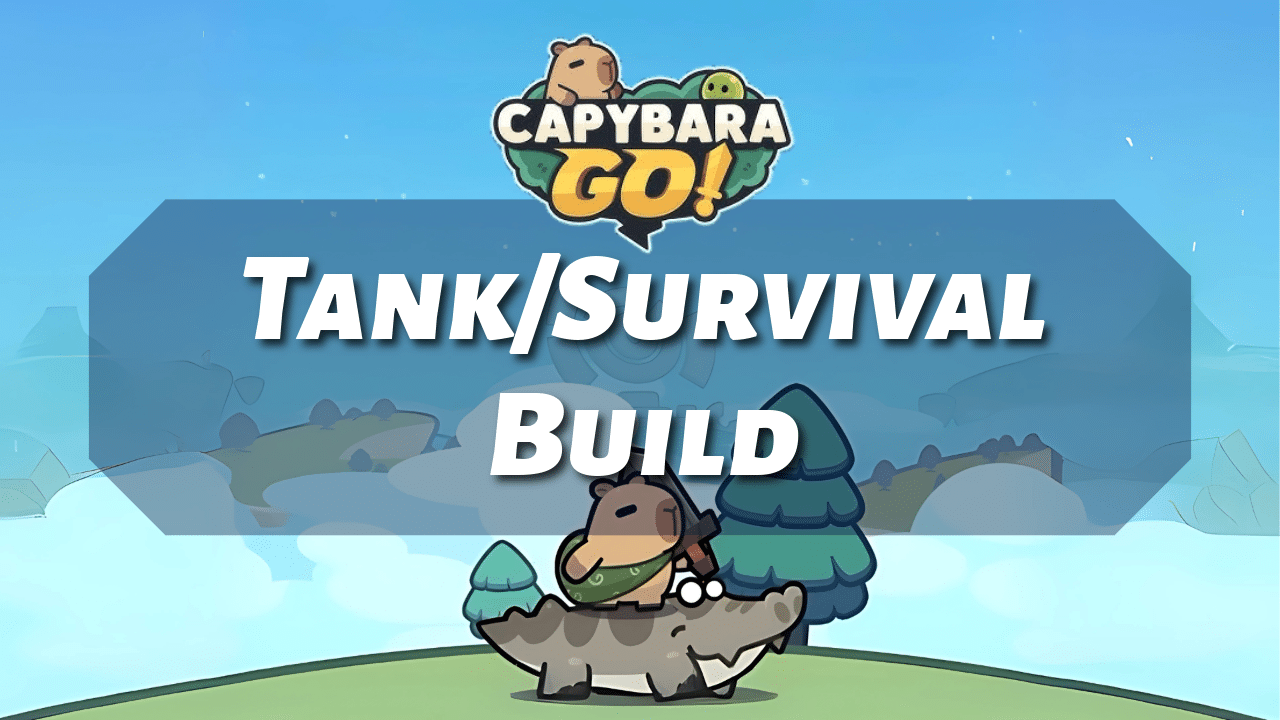
Introduction to Tank/Survival Builds
Capybara Go Tank/Survival Build focuses on maximizing a capybara’s ability to absorb and recover from damage over time. This build prioritizes HP, defense, and healing regeneration stats to ensure your capybara can survive long engagements, especially when facing enemies that deal consistent or burst damage. It’s designed for scenarios where the capybara is not the primary damage dealer but instead acts as a frontline presence, allowing abilities or items—such as passive damage sources—to wear down enemies over time.
For example, if a build incorporates Holy Statue or other passive DPS tools, the capybara only needs to survive long enough for those tools to do the work. This approach becomes especially effective in later chapters, where enemies can deal heavy one-shot damage, and having enough sustain is the only way to endure and progress.
Key Concepts for Survivability
One of the core principles of a Tank/Survival Build in Capybara Go is damage reduction. This concept revolves around minimizing the amount of incoming damage through passive effects, skills, and gear that reduce enemy output. Reducing the impact of attacks allows a capybara to stay alive significantly longer, especially when facing mobs or bosses that deal high burst or consistent damage. Skills that offer flat damage reduction or equipment that mitigates incoming damage are especially valuable. By lowering how much damage is taken per hit, the build buys time for healing, shields, or support skills to activate.
Health and defense stats are equally important. A high HP pool enables the capybara to tank multiple hits, including powerful rage skills or chain attacks from mobs. While the game doesn’t always break down the defensive formulas, it’s clear that stacking HP improves survivability across most encounters. Many players aim to build enough health to survive surprise burst phases and recover with healing items or abilities. The greater the HP, the more margin for error you have during tough waves or boss fights.
Temporary shields offer another strong layer of protection and are a cornerstone of this build. Shields act as a buffer against damage, allowing you to absorb attacks without losing actual HP. The Guardian Ring stands out in this category, frequently used in pairs to maximize shield uptime. It’s considered essential for progressing through tougher chapters. Notably, the Knight of the End hero provides additional survivability, and at the mythic tier, its shield effect is converted into bonus attack, offering both protection and a minor offensive boost.
Crowd control contributes to survival by reducing the number of enemy actions. Freezing, stunning, or slowing enemies can prevent them from attacking altogether, which is critical during high-density stages or mob rushes. The Icy Bubble is frequently used for this purpose, and two mythic-tier Icy Bubbles are often included in survival builds for consistent freeze coverage. Additionally, the Doll hero, when upgraded through Ghost inheritance tiers, offers a powerful stun rate that passively disrupts enemy actions and creates breathing room during fights.
Revive mechanics offer one final layer of defense by giving the capybara a second chance after death. The Revival Cape, rated S-Tier, is especially valuable in stages with double slimes or bursty enemy patterns. Combined with a revive skill, it greatly increases a build’s forgiveness, letting the capybara re-enter the fight at a crucial moment. This mechanic can be the difference between resetting a run and clutching a victory. It ensures that even if everything else fails, there’s still a final backup to keep the run going.
Equipment for Survival
When building for survival in Capybara Go, armor is a critical component, with several standout pieces suited for tank builds. The Dragon Breath Armor, ranked S-Tier, is one of the most sought-after pieces due to its strong defensive capabilities and performance in late-game chapters. Players often prioritize acquiring this armor early on, as its benefits heavily contribute to survivability in more difficult content. Before obtaining Dragon Breath, Silverscale Plate and Hard Armor serve as reasonable early-game options, offering basic defensive coverage. Once players obtain a purple-quality Tunic, it is often used as an alternative due to its reliable performance in sustaining through combat phases.
The Revival Cape is another top-tier armor item, offering a powerful revive effect that allows the capybara to come back after receiving lethal damage. This is especially helpful during stages where multiple enemies or burst-heavy encounters are common. It’s highly valued in double slime stages or boss fights where reviving can make the difference between failure and a successful clear. By giving the player a second chance, the Revival Cape adds a critical margin of error to high-stakes runs.
Rings play a key role in reinforcing survivability, with the Guardian Ring standing as a staple. It provides a shield that absorbs damage, which is especially effective in reducing incoming burst and chip damage. Many players choose to equip two Guardian Rings to maximize shield uptime, especially in earlier chapters where sustainability is a challenge. Judgment Ring is occasionally used alongside Guardian Ring to balance survivability with offense, but using two Judgment Rings sacrifices too much defense for most survival-focused setups. Magic Ring and Dragon Ball Ring are more situational, typically reserved for damage-oriented builds or for strategies that need to hit the enemy backline.
For necklaces, Icy Bubble offers powerful indirect survival through freeze effects that stop enemies from attacking. This crowd control not only interrupts enemy actions but also buys time for healing, shields, and skill cooldowns. Some builds include two mythic Icy Bubbles for constant freezing to manage mob density and boss mechanics. Bloody Grail and Glory Proof are also mentioned as viable options, especially in dagger builds or when additional HP is needed. However, Glory Proof doesn’t reach its full potential until it’s upgraded to mythic, where its durability boost becomes more significant.
While there isn’t a definitive weapon tied strictly to tank builds, survival-focused capybaras still need a way to deal damage to progress. Weapon choice should complement the rest of the build—options with crowd control, healing effects, or consistent AoE damage can help maintain pressure while surviving. Weapons like the Whisperer or others that align with a combo or freeze-based setup can fit well into survival-oriented strategies. Ultimately, the weapon should support the longevity of the build without sacrificing too much offense, especially in later chapters where balance becomes more important.
Skills for Survival
Skills for survival in Capybara Go focus on reducing incoming damage, recovering from lethal situations, and maintaining consistent performance throughout prolonged fights. One of the most critical skills for a tank build is Battle-Hardened, rated S+ Tier, which increases damage reduction each round. This stacking effect becomes more powerful the longer a battle continues, making it ideal for boss fights or high-wave encounters where endurance is key. Once the reduction reaches its cap, the capybara becomes significantly harder to kill, allowing more time for passive damage effects or crowd control to take effect. This skill is often considered a foundation for any survival-focused setup.
Other skills that provide flat or percentage-based damage reduction are also valuable for enhancing survivability. These effects reduce the total incoming damage from basic attacks, mob skills, or boss rage abilities, which helps prevent sudden deaths or overwhelming chip damage over time. When paired with healing, shields, or crowd control, damage reduction allows the capybara to stay in the fight longer, outlasting enemies through attrition. Skills that grant these reductions early in battle are especially useful in chapters with quick mob rushes or fast-hitting bosses. These abilities can be the difference between stabilizing a wave and getting overwhelmed in the first few seconds.
Revive skills play a unique role in survival builds by giving the capybara a chance to return after taking fatal damage. When combined with the Revival Cape, this creates a layered defense that can absorb both mistake-driven deaths and unavoidable high-damage bursts. Revive effects are especially helpful in stages with back-to-back elite enemies or double boss phases, where surviving the first encounter is only part of the challenge. By bringing the capybara back into the fight automatically, revive skills extend the opportunity to clear content that might otherwise be too punishing. This safety net makes them a popular inclusion in late-game and challenge-based builds.
Combo Mastery and War Veteran are also important skills in survival-focused builds, not just for damage, but for their synergy with survivability mechanics. Combo Mastery allows smoother activation of combo-based gear or effects, improving damage output while maintaining control of the battlefield. War Veteran provides additional battle endurance, which may include effects like stat scaling with turns or added resilience under pressure. When combined with damage reduction skills or healing effects, these two can help push through chapters that rely heavily on consistency and staying power. The blend of offensive rhythm and defensive stability makes them strong assets in a well-rounded survival strategy.
Pets for Survival
Choosing the right pets for a survival-focused build in Capybara Go is crucial, as they can significantly enhance a capybara’s defensive capabilities. Pets that increase maximum HP or provide damage reduction are ideal because they directly contribute to withstanding more hits and reducing the threat of sudden death from burst attacks. These defensive boosts stack well with armor and skills focused on survivability, creating a layered defense that is harder for enemies to break through. Some pets may also offer passives or active skills that apply shields, healing, or buffs that further reinforce survivability. Investing in pets with tank-focused traits is a reliable way to improve performance in higher-level chapters where enemies deal more consistent and deadly damage.
Among the most commonly used pets for survival builds are the Ice Fox and the Elephant. The Ice Fox contributes to crowd control by freezing enemies, which directly reduces the number of incoming attacks during a fight. Freezing can disrupt mob waves or even bosses, creating safe windows for healing, cooldown recovery, or repositioning. The Elephant, on the other hand, provides a healing ability and is recognized as a solid pet even at the legendary tier. Its healing can help sustain the capybara through drawn-out battles, making it an excellent choice for players focusing on endurance and damage mitigation over time.
Additionally, securing damage-over-time (DoT) reduction on a pet can be critical when facing enemies that inflict poison or burn effects. These types of damage can bypass shields and continue to drain HP even after the initial attack. Pets that help reduce this kind of incoming damage can provide a subtle but impactful boost to survivability. This is particularly important in stages where poison is frequently applied by mobs, slimes, or elite enemies. Reducing DoT damage ensures that a capybara can endure longer without relying too heavily on emergency healing or revives.
Mounts and Artifacts for Survival
Mounts and artifacts play a supporting but significant role in survival-focused builds in Capybara Go. Choosing a mount that grants an HP bonus helps increase the capybara’s maximum health, giving it more buffer against burst damage and increasing the effectiveness of healing and shields. Similarly, using an artifact that offers damage reduction directly reduces the amount of incoming damage, making it easier to stay alive through multiple waves or prolonged fights. These two attributes—high HP and damage mitigation—form a strong defensive foundation when paired with tank-focused gear, skills, and pets. Together, they extend the capybara’s ability to absorb hits and remain effective across long battles.
For builds that use the Reaper Staff, certain mounts and artifacts can provide additional advantages that align with both damage output and survivability. Luminous Dragon and Diego are recommended for use in chapter progression. Diego, in particular, is valued for its synergy with combo-based builds, which can support smoother skill rotations and trigger additional effects that improve both offense and defense. Sphinx is often used in PvP and other PvE scenarios where survivability and strategic timing are critical, likely due to its utility-focused bonuses that support sustained performance rather than short bursts. These mounts contribute to stability in battle while also enhancing traits that benefit survival indirectly.
Artifacts like the Spear of Thor are useful in Reaper Staff builds because of their ability to boost damage output, which helps clear enemies faster. Faster clears reduce the duration of exposure to enemy attacks, indirectly improving survivability by shortening the time the capybara remains in danger. This is especially helpful in chapters with high enemy density or stages that require dealing with multiple waves in quick succession. Although the Spear of Thor focuses more on offense, its contribution to efficient combat pacing makes it a practical inclusion for survival setups that also rely on progress speed.
The Laputa mount is another valuable option due to its bonus to combo rate, which benefits a wide range of builds. A higher combo rate improves the frequency and consistency of combo-based skill and gear activations, supporting smoother gameplay and increasing both damage and control. This effect is useful for survival builds that rely on timing, freeze effects, or passive procs, as it increases the chances of landing disabling effects before enemies strike. The enhanced combo flow can also assist in maintaining pressure, allowing for more predictable combat and fewer surprises from enemy abilities.
Gameplay and Strategy for Survival Builds
The core strategy of a Capybara Go Tank/Survival Build is to ensure the capybara can endure incoming damage long enough to secure victory through sustained damage, utility effects, or support elements such as revives and crowd control. This approach prioritizes survivability over burst damage, aiming to outlast opponents by absorbing or mitigating hits while slowly wearing down enemies. It is particularly effective in battles where enemies deal high, continuous damage, and a quick offensive win is not feasible. The focus on endurance allows players to push further into chapters or challenge content where glass cannon approaches would fail. Survivability becomes the backbone of the build, allowing utility skills, pet effects, or damage-over-time mechanics to take effect without interruption.
In situations where the capybara dies too quickly, it becomes essential to increase overall durability by investing in damage reduction, boosting health, and leveraging crowd control to reduce enemy actions. Increasing damage reduction directly cuts down on the harm taken from both basic and special attacks, while more HP gives the capybara the resilience to survive initial bursts and recover. Crowd control effects such as freezing, stunning, or slowing enemies play a supportive role by reducing the number of incoming attacks, effectively buying time for skills and heals to activate.
Maintaining a balance between offense and defense is key to making a survival build effective. While tanking hits is important, the capybara still needs to deal enough damage to clear stages before time runs out or before it becomes overwhelmed. This can be achieved by carefully selecting gear, mounts, and artifacts that offer both survivability and combat utility. Weapons or skills that scale with defense or offer sustain effects, such as lifesteal or passive damage, contribute to this balance. Without a strong offensive component, even the most durable build may stall in content that requires timely clears or damage-based mechanics.













